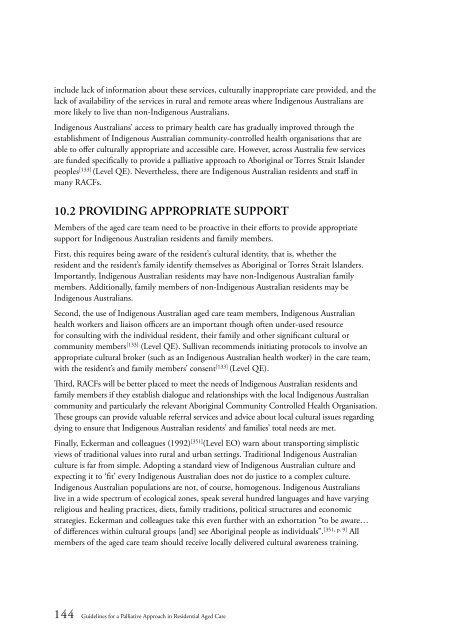Guidelines for a Palliative Approach in Residential Aged Care
Guidelines for a Palliative Approach in Residential Aged Care
Guidelines for a Palliative Approach in Residential Aged Care
Create successful ePaper yourself
Turn your PDF publications into a flip-book with our unique Google optimized e-Paper software.
<strong>in</strong>clude lack of <strong>in</strong><strong>for</strong>mation about these services, culturally <strong>in</strong>appropriate care provided, and the<br />
lack of availability of the services <strong>in</strong> rural and remote areas where Indigenous Australians are<br />
more likely to live than non-Indigenous Australians.<br />
Indigenous Australians’ access to primary health care has gradually improved through the<br />
establishment of Indigenous Australian community-controlled health organisations that are<br />
able to offer culturally appropriate and accessible care. However, across Australia few services<br />
are funded specifically to provide a palliative approach to Aborig<strong>in</strong>al or Torres Strait Islander<br />
peoples [133] (Level QE). Nevertheless, there are Indigenous Australian residents and staff <strong>in</strong><br />
many RACFs.<br />
10.2 PROVIDING APPROPRIATE SUPPORT<br />
Members of the aged care team need to be proactive <strong>in</strong> their ef<strong>for</strong>ts to provide appropriate<br />
support <strong>for</strong> Indigenous Australian residents and family members.<br />
First, this requires be<strong>in</strong>g aware of the resident’s cultural identity, that is, whether the<br />
resident and the resident’s family identify themselves as Aborig<strong>in</strong>al or Torres Strait Islanders.<br />
Importantly, Indigenous Australian residents may have non-Indigenous Australian family<br />
members. Additionally, family members of non-Indigenous Australian residents may be<br />
Indigenous Australians.<br />
Second, the use of Indigenous Australian aged care team members, Indigenous Australian<br />
health workers and liaison officers are an important though often under-used resource<br />
<strong>for</strong> consult<strong>in</strong>g with the <strong>in</strong>dividual resident, their family and other significant cultural or<br />
community members [133] (Level QE). Sullivan recommends <strong>in</strong>itiat<strong>in</strong>g protocols to <strong>in</strong>volve an<br />
appropriate cultural broker (such as an Indigenous Australian health worker) <strong>in</strong> the care team,<br />
with the resident’s and family members’ consent [133] (Level QE).<br />
Third, RACFs will be better placed to meet the needs of Indigenous Australian residents and<br />
family members if they establish dialogue and relationships with the local Indigenous Australian<br />
community and particularly the relevant Aborig<strong>in</strong>al Community Controlled Health Organisation.<br />
These groups can provide valuable referral services and advice about local cultural issues regard<strong>in</strong>g<br />
dy<strong>in</strong>g to ensure that Indigenous Australian residents’ and families’ total needs are met.<br />
F<strong>in</strong>ally, Eckerman and colleagues (1992) [351] (Level EO) warn about transport<strong>in</strong>g simplistic<br />
views of traditional values <strong>in</strong>to rural and urban sett<strong>in</strong>gs. Traditional Indigenous Australian<br />
culture is far from simple. Adopt<strong>in</strong>g a standard view of Indigenous Australian culture and<br />
expect<strong>in</strong>g it to ‘fit’ every Indigenous Australian does not do justice to a complex culture.<br />
Indigenous Australian populations are not, of course, homogenous. Indigenous Australians<br />
live <strong>in</strong> a wide spectrum of ecological zones, speak several hundred languages and have vary<strong>in</strong>g<br />
religious and heal<strong>in</strong>g practices, diets, family traditions, political structures and economic<br />
strategies. Eckerman and colleagues take this even further with an exhortation “to be aware…<br />
of differences with<strong>in</strong> cultural groups [and] see Aborig<strong>in</strong>al people as <strong>in</strong>dividuals”. [351, p. 9] All<br />
members of the aged care team should receive locally delivered cultural awareness tra<strong>in</strong><strong>in</strong>g.<br />
144 <strong>Guidel<strong>in</strong>es</strong> <strong>for</strong> a <strong>Palliative</strong> <strong>Approach</strong> <strong>in</strong> <strong>Residential</strong> <strong>Aged</strong> <strong>Care</strong>
















